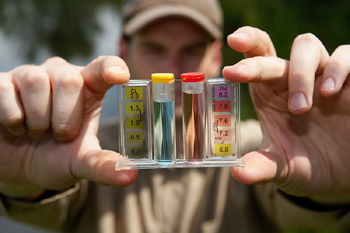Stay Informed
Popular Articles
- Hiatal Hernia: Hidden Cause of Chronic Illness
- Small Intestinal Bacterial Overgrowth (SIBO)
- Applied Lymphology: Unlocking the Secret to Pain Relief
- An Introduction to Constitutional Iridology
- The Low Down on Liver Detoxification
- An Energetic and Emotional Approach to Cancer
- Fat Facts
- Marrow in the Bones
- Blood Type and Nutrition
- Cardiac Herbs: Beyond Hawthorn
Quick Search
The School of Modern Herbal Medicine




pH Balancing: Important Key to Good Health
- 5/11/2008
- Categorized in: General Health
This is page 1 of a four-part article.
 Which do you think would be a better breeding ground for mosquitos; a bubbling mountain brook or a pool of stagnant swamp water? We all recognize that stagnant water is a better breeding ground for mosquitos than a fast moving mountain stream. Similarly, we know that habitat or terrain is a factor in the growth of all living creatures.
Which do you think would be a better breeding ground for mosquitos; a bubbling mountain brook or a pool of stagnant swamp water? We all recognize that stagnant water is a better breeding ground for mosquitos than a fast moving mountain stream. Similarly, we know that habitat or terrain is a factor in the growth of all living creatures.
The same thing holds true for our bodies. Our bodies have an internal environment which herbalists refer to as our biological terrain. Our biological terrain is based on the composition and quality of the fluids our cells live in and depend on, including blood, lymph, gastric juices, etc. When these fluids are in proper balance, our cells prosper. When they are out of balance, our cells not only fail to thrive, they create an environment conducive to the growth of unhealthy things such as fungi, bacteria, viruses, parasites or cancer cells.
Biological terrain is not a new concept, but it is one that is largely overlooked in our “germ” focused society. We tend to believe that avoiding or killing microorganisms is the only way to prevent disease. We fail to realize that before disease organisms can get a foothold, the body must provide an environment that is favorable to their growth. If the biological terrain is healthy, then disease “germs” cannot proliferate. This is a major factor in a body's resistance to any illness.
One of the most fundamental factors in the health of our biological terrain is pH, the acid/alkaline balance of our body's tissues and fluids. When one's pH is balanced, it works to maintain the health of the entire system. When pH becomes imbalanced, it contributes to the development of many types of disease, including infections of all kinds, cancer, bone and joint deterioration, nervous disorders, digestive disturbances, parasites and much, much more.
What is pH?
The term pH is short for “the potential of hydrogen.” Without getting overly technical, it refers to the acidity or alkalinity of a solution. The pH scale goes from 1—14 with 1 being purely acidic and 14 being purely alkaline. Water (H20) has a neutral pH of 7. Anything below 7 is acidic; anything above 7 is alkaline.
In our bodies, mildly acid compounds provide structural integrity and keep tissues firm and toned. Too much acid, however, causes our tissues to become overly rigid and dry. Excess acid in the body contributes to conditions like hardening of the arteries, high blood pressure, arthritis, gout, muscle stiffness and pain, tension, anxiety, osteoporosis, kidney stones, insomnia and increased risk of cancer and infection. Excess acid is the most common pH imbalance people experience.
In contrast, a mildly alkaline state contributes to fluidity and relaxation in the body. To understand what excess alkalinity does we can look at symptoms of poisoning from highly alkaline plants. Ingestion of many alkaloid poisons results in nausea, vomiting, tissue breakdown (loss of structural tone) and hallucinations. So, generally speaking, excess alkalinity in the body contributes to excess laxity of tissues, lethargy and mental instability.
The key, of course, is to keep your body's pH in balance. Different organs or tissues require different pH values for optimal function. The skin has a slightly acidic coating which protects the body from infection and holds the skin together tightly. The pH of the saliva should range between 6.0—7.0, as the enzymes in saliva only operate within that pH range. The gastric juices in our stomach need to be between 1.0—3.5 to facilitate protein digestion. Our blood has a pH of about 7.3—7.4. Our urinary pH can fluctuate between 4.5—8.0.
How to Test Your pH
pH testing is done by using pH paper to check the level of acidity or alkalinity in urine and saliva. Since pH values vary throughout the day, best results are obtained by taking several readings per day over the course of a week and averaging the results. The best times to check your pH are first thing in the morning before breakfast, shortly before lunch or dinner, and right before bedtime.
These readings are taken by obtaining samples of urine and saliva (these can be collected in a paper cup or other container) and dipping a pH test strip into the sample (pH test strips are available from Nature's Sunshine Products). You then compare the color of the strip with a color key on the package. This tells you the pH value of the sample. If you prefer, you can hold the pH strip directly under the flow of urine. When checking your saliva, however, don't put the pH strip in your mouth—just spit on the strip. Be sure to do the saliva test prior to taking any food or drink and before brushing your teeth.
Record your pH readings on a piece of paper, and take several readings a day for about a week. Then average your findings. If your body's pH values are in balance, you should find that your saliva averages between 6.0—7.0 with 6.4—6.6 being the optimal average range. The pH of your urine should fluctuate between about 5.0—7.5, with the optimal average range again being about 6.4—6.6.
If your body is not operating within these parameters, then you probably need to take action to balance your body's biochemistry. This article will help you learn how to do this.
